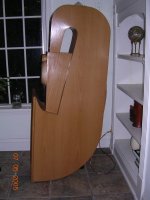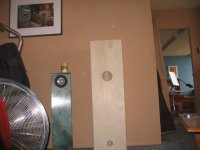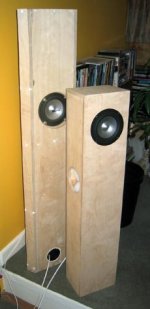Hi Andy
The VTL is already a Daline. From what I can gather, the VTL was extensively voiced before publication and commercial use. If you go the route of a modified top chamber (changing the volume), the Daline articles may help but I found them ambiguous, to say the least. I think the stuffing in the upper chamber and end of the line is the best way to modify them. You could try removing all the stuffing to begin with and see if it makes the effect worse.
I haven't built the VTL but can vouch for the standard MLTL. Lots of speed, body and LF extension.
The VTL is already a Daline. From what I can gather, the VTL was extensively voiced before publication and commercial use. If you go the route of a modified top chamber (changing the volume), the Daline articles may help but I found them ambiguous, to say the least. I think the stuffing in the upper chamber and end of the line is the best way to modify them. You could try removing all the stuffing to begin with and see if it makes the effect worse.
I haven't built the VTL but can vouch for the standard MLTL. Lots of speed, body and LF extension.
Got my camera to work briefly. The Blue speaker is an Alpha line.
Sounds good with baffle step comp. The other is MLTL triangle taken
off Jordan site. Front baffle extends an additional 4". Interior size the
same. I'm in no rush to finish as I do like the alpha with the equalization.
Sounds good with baffle step comp. The other is MLTL triangle taken
off Jordan site. Front baffle extends an additional 4". Interior size the
same. I'm in no rush to finish as I do like the alpha with the equalization.
Attachments
Let us know how they compare when you finish the triangle.
How low does the Alphaline design go?
How low does the Alphaline design go?
Colin said:Let us know how they compare when you finish the triangle.
How low does the Alphaline design go?
I don't have a way to measure but as I remember in the AE article F3 was 45hz.
Also the article stated that the Bass coming out the port of shorter pipe was louder
than a big fat pipe....To my ears I think I'm hearing that 45hz loud & clear.
Jordan JX92S with TUBA horn
I need the map of Jordan JX92S with TUBA horn detail,
Can Who give me ! thanks very much!
I need the map of Jordan JX92S with TUBA horn detail,
Can Who give me ! thanks very much!
Re: Jordan JX92S with TUBA horn
Best to email HM directly
http://www.diyaudio.com/forums/member.php?action=getinfo&userid=12672
http://fullrangedriver.com/gallery/displayimage.php?album=3&pos=62
dave
banhtieubanhbo said:I need the map of Jordan JX92S with TUBA horn detail,
Can Who give me ! thanks very much!
Best to email HM directly
http://www.diyaudio.com/forums/member.php?action=getinfo&userid=12672
http://fullrangedriver.com/gallery/displayimage.php?album=3&pos=62
dave
I mentioned earlier in this thread that I had an Auguspurger line on the go for the JX92. I finally finished it over Easter and have had it running for 24 hours. His tables for the coupled cavity TL give a compact line tuned to 70Hz with an overall enclosure volume of around 11 litres. It makes for a compact, floor-stander which tucks away into corners.
The sound isn't too bad. All the JX92 strengths are there, with clear sound, lots of detail and terrific imaging. It doesn't go as deep as the 48" MLTLs. It reaches 60Hz and then tails off. There is plenty of body in what bass there is. In fact, there is a little bit too much body as it sounds 'loud' on voices, which makes me suspect there's a resonance I need to tune out. I've only done a first stuff with the wadding, so no experimentation yet.
I built this out of curiosity more than anything else. It makes a neat box for use with a sub and it doesn't require a stand. I specifically wanted to try something I could shove away in corners and augment with a separate bass. At the moment, they're standing in the middle of the room and I don't feel they require any BSC, though I'll play with that later in the week to see what happens.
Ironically, the cabinet has come out about the same size as the smaller, 31" MLTL, although that needs a stand to get the driver up to ear height.
Pic attached, next to the MLTL.
The sound isn't too bad. All the JX92 strengths are there, with clear sound, lots of detail and terrific imaging. It doesn't go as deep as the 48" MLTLs. It reaches 60Hz and then tails off. There is plenty of body in what bass there is. In fact, there is a little bit too much body as it sounds 'loud' on voices, which makes me suspect there's a resonance I need to tune out. I've only done a first stuff with the wadding, so no experimentation yet.
I built this out of curiosity more than anything else. It makes a neat box for use with a sub and it doesn't require a stand. I specifically wanted to try something I could shove away in corners and augment with a separate bass. At the moment, they're standing in the middle of the room and I don't feel they require any BSC, though I'll play with that later in the week to see what happens.
Ironically, the cabinet has come out about the same size as the smaller, 31" MLTL, although that needs a stand to get the driver up to ear height.
Pic attached, next to the MLTL.
Attachments
Hi..Do you have a drawing of the inside? Looks neat with the port on the side. You might find these scary with a baffle step..
Lucius
Lucius
Colin said:In fact, there is a little bit too much body as it sounds 'loud' on voices, which makes me suspect there's a resonance I need to tune out.
Male voice "boom" or female voice screeching?
Difficult to know whether this is a new species of speaker cabinet, or just a very large port!
Is this the optimal size , or is there a range of possibles for the design?
Andy
The design uses alignment tables so you put in the parameters and out pops an optimised design (length, volume and size of coupling cavity. The hole in the side is the line exit, rather than a port as such. I cut it round to fit a piece of trim I can use.
For anyone interested, the details are:
line length - 37.8"
line tuned to 90Hz
f3 = 72Hz
Vp = 11.32 litres
Cavity is recommended as one third total volume, so cavity is 3.8L, line is 7.6L. I've allowed an extra 0.4L in the cavity for the driver volume. Area of line works out at 12.18 ins^2.
Other dimensions you can adjust to suit - if you want a wider cabinet, for instance.
My only doubt about my build is that I took the line length to mean the overall length of the line part of the enclosure, with the cavity sitting on top of that. Arguably that has given a total line length of 48" but on the other hand it means the line cross-section stays smaller and there's a clearer demarcation between line and cavity.
The slight shout is most evident on male speaking voices and I think I need to adjust the filling in the cavity, which is probably too light. I'm also comparing to the triangular MLTLs, which has no reflective internal surfaces, whereas this box is rectangular.
There are also alignment tables for a tapered line (no cavity) and off-set design (driver roughly 1/5 down a narrower line). Previous experiment with an offset line didn't work too well (not enough space behind the drivers so the sound was very thin) but the tapered one looks promising and gives a slightly smaller cabinet.
For anyone interested, the details are:
line length - 37.8"
line tuned to 90Hz
f3 = 72Hz
Vp = 11.32 litres
Cavity is recommended as one third total volume, so cavity is 3.8L, line is 7.6L. I've allowed an extra 0.4L in the cavity for the driver volume. Area of line works out at 12.18 ins^2.
Other dimensions you can adjust to suit - if you want a wider cabinet, for instance.
My only doubt about my build is that I took the line length to mean the overall length of the line part of the enclosure, with the cavity sitting on top of that. Arguably that has given a total line length of 48" but on the other hand it means the line cross-section stays smaller and there's a clearer demarcation between line and cavity.
The slight shout is most evident on male speaking voices and I think I need to adjust the filling in the cavity, which is probably too light. I'm also comparing to the triangular MLTLs, which has no reflective internal surfaces, whereas this box is rectangular.
There are also alignment tables for a tapered line (no cavity) and off-set design (driver roughly 1/5 down a narrower line). Previous experiment with an offset line didn't work too well (not enough space behind the drivers so the sound was very thin) but the tapered one looks promising and gives a slightly smaller cabinet.
RAndyB said:Difficult to know whether this is a new species of speaker cabinet, or just a very large port!
P.S. No, it's not a new species. I've read mention of these in articles dating back to the 1960s and Augspurger uses a modified horn calculation program to model them. Some writers describe them as a reflex with an over-long port, others as a TL with a coupling chamber.
Colin,
Could it be that the shout is a lack of baffle step correction? so the men seem to be "projecting" ?
I am glad YOU did the experiment - that is one I shan't be bothering with!
Andy
Could it be that the shout is a lack of baffle step correction? so the men seem to be "projecting" ?
I am glad YOU did the experiment - that is one I shan't be bothering with!
Andy
Colin said:others as a TL with a coupling chamber
Radford & IMF both used this TL topology.
dave
Hi Dave
Yes, I remember those speakers. I think the topology was perhaps more to accommodate the B139 and Radford drivers rather than a deliberate attempt at a coupling chamber. Bailey's mark 2 TL split the cabinet into three triangular lines and did away with the chamber altogether. I haven't heard the Radford designs but I've listened a couple of IMF speakers and the similar Cambridge TL and remember being impressed by the sheer power of the bass.
The Augspurger line doesn't claim extended bass, but aims to maintain the bass at the same output level and efficiency as the midrange. He says it will have extension to a similarly sized sealed box but with better power handling at LF.
My boxes seem to confirm this. They're sounding pretty good, especially on acoustic music. On most material, I'm not noticing any lack of LF. What is there is well balanced with just the right amount of weight.
I suspect the very mild shout on male voices is because I haven't filled the chamber with sufficient stuffing. I had a problem with the BAF wadding - it got tangled in one of the t-nuts as I fitted the driver and jammed the bolt. I had to saw off the bolt head to release it. A novel problem. I removed some of the stuffing to avoid this. In future, the stuffing behind the driver goes inside a stocking or something similar.
Yes, I remember those speakers. I think the topology was perhaps more to accommodate the B139 and Radford drivers rather than a deliberate attempt at a coupling chamber. Bailey's mark 2 TL split the cabinet into three triangular lines and did away with the chamber altogether. I haven't heard the Radford designs but I've listened a couple of IMF speakers and the similar Cambridge TL and remember being impressed by the sheer power of the bass.
The Augspurger line doesn't claim extended bass, but aims to maintain the bass at the same output level and efficiency as the midrange. He says it will have extension to a similarly sized sealed box but with better power handling at LF.
My boxes seem to confirm this. They're sounding pretty good, especially on acoustic music. On most material, I'm not noticing any lack of LF. What is there is well balanced with just the right amount of weight.
I suspect the very mild shout on male voices is because I haven't filled the chamber with sufficient stuffing. I had a problem with the BAF wadding - it got tangled in one of the t-nuts as I fitted the driver and jammed the bolt. I had to saw off the bolt head to release it. A novel problem. I removed some of the stuffing to avoid this. In future, the stuffing behind the driver goes inside a stocking or something similar.
Colin said:Yes, I remember those speakers. I think the topology was perhaps more to accommodate the B139 and Radford drivers rather than a deliberate attempt at a coupling chamber.
I think in the Radfords it was very deliberate... somewhere i read a reference to some stuff Radford said about the speaker, and that was actually what twigged on me that the Radfords & IMFs were Dalines.
Bailey's mark 2 TL split the cabinet into three triangular lines and did away with the chamber altogether.
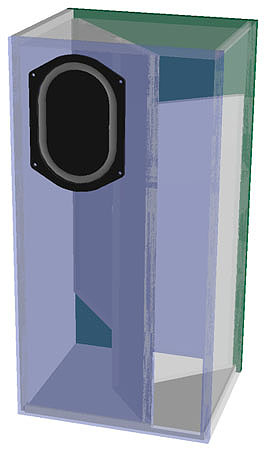
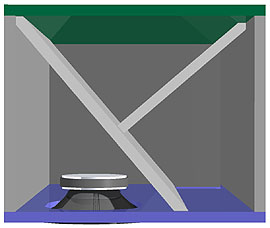
I haven't heard the Radford designs but I've listened a couple of IMF speakers and the similar Cambridge TL and remember being impressed by the sheer power of the bass.
Radford S90s were what originally got me going on TLs, and i have sold (& owned) IMFs.
Scott & i are working on a design that is inspired by these, and intended to be a modern rendition.
dave
If we are doing nostalgia and triangles: the first speaker cabinets I built (in 1969/1970) were the Paraline design by Rex Baldock. This, and some bad experiences with rectangular boxes, are the reason for my interest in TQW cabinets, and TLs.
The Paralines worked well with the right drivers. Of course the definition of "worked well" has changed in the intervening decades. Back then it was useful not to have the 15kHz and above range because the hiss was less prominent!
Andy
The Paralines worked well with the right drivers. Of course the definition of "worked well" has changed in the intervening decades. Back then it was useful not to have the 15kHz and above range because the hiss was less prominent!
Andy
- Status
- Not open for further replies.
- Home
- Loudspeakers
- Full Range
- JX92S now in full voice
